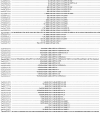Identification and characterization of wheat long non-protein coding RNAs responsive to powdery mildew infection and heat stress by using microarray analysis and SBS sequencing
- PMID: 21473757
- PMCID: PMC3079642
- DOI: 10.1186/1471-2229-11-61
Identification and characterization of wheat long non-protein coding RNAs responsive to powdery mildew infection and heat stress by using microarray analysis and SBS sequencing
Abstract
Background: Biotic and abiotic stresses, such as powdery mildew infection and high temperature, are important limiting factors for yield and grain quality in wheat production. Emerging evidences suggest that long non-protein coding RNAs (npcRNAs) are developmentally regulated and play roles in development and stress responses of plants. However, identification of long npcRNAs is limited to a few plant species, such as Arabidopsis, rice and maize, no systematic identification of long npcRNAs and their responses to abiotic and biotic stresses is reported in wheat.
Results: In this study, by using computational analysis and experimental approach we identified 125 putative wheat stress responsive long npcRNAs, which are not conserved among plant species. Among them, some were precursors of small RNAs such as microRNAs and siRNAs, two long npcRNAs were identified as signal recognition particle (SRP) 7S RNA variants, and three were characterized as U3 snoRNAs. We found that wheat long npcRNAs showed tissue dependent expression patterns and were responsive to powdery mildew infection and heat stress.
Conclusion: Our results indicated that diverse sets of wheat long npcRNAs were responsive to powdery mildew infection and heat stress, and could function in wheat responses to both biotic and abiotic stresses, which provided a starting point to understand their functions and regulatory mechanisms in the future.
© 2011 Xin et al; licensee BioMed Central Ltd.
Figures













Similar articles
-
Diverse set of microRNAs are responsive to powdery mildew infection and heat stress in wheat (Triticum aestivum L.).BMC Plant Biol. 2010 Jun 24;10:123. doi: 10.1186/1471-2229-10-123. BMC Plant Biol. 2010. PMID: 20573268 Free PMC article.
-
Genome-wide identification of TaeGRASs responsive to biotic stresses and functional analysis of TaeSCL6 in wheat resistance to powdery mildew.BMC Genomics. 2024 Nov 27;25(1):1149. doi: 10.1186/s12864-024-11041-3. BMC Genomics. 2024. PMID: 39604842 Free PMC article.
-
Wheat homologs of yeast ATG6 function in autophagy and are implicated in powdery mildew immunity.BMC Plant Biol. 2015 Apr 1;15:95. doi: 10.1186/s12870-015-0472-y. BMC Plant Biol. 2015. PMID: 25888209 Free PMC article.
-
Exploration of small non coding RNAs in wheat (Triticum aestivum L.).Plant Mol Biol. 2012 Sep;80(1):67-73. doi: 10.1007/s11103-011-9835-4. Epub 2011 Oct 19. Plant Mol Biol. 2012. PMID: 22009635 Review.
-
Transcriptome analysis of genes related to resistance against powdery mildew in wheat-Thinopyrum alien addition disomic line germplasm SN6306.Gene. 2016 Sep 15;590(1):5-17. doi: 10.1016/j.gene.2016.06.005. Epub 2016 Jun 2. Gene. 2016. PMID: 27265028 Review.
Cited by
-
Plant Noncoding RNAs: Hidden Players in Development and Stress Responses.Annu Rev Cell Dev Biol. 2019 Oct 6;35:407-431. doi: 10.1146/annurev-cellbio-100818-125218. Epub 2019 Aug 12. Annu Rev Cell Dev Biol. 2019. PMID: 31403819 Free PMC article. Review.
-
Transcription Factors Associated with Abiotic and Biotic Stress Tolerance and Their Potential for Crops Improvement.Genes (Basel). 2019 Sep 30;10(10):771. doi: 10.3390/genes10100771. Genes (Basel). 2019. PMID: 31575043 Free PMC article. Review.
-
Role of long non-coding RNA in regulatory network response to Candidatus Liberibacter asiaticus in citrus.Front Plant Sci. 2023 Feb 20;14:1090711. doi: 10.3389/fpls.2023.1090711. eCollection 2023. Front Plant Sci. 2023. PMID: 36890903 Free PMC article.
-
Long Non-Coding RNAs: New Players in Plants.Int J Mol Sci. 2022 Aug 18;23(16):9301. doi: 10.3390/ijms23169301. Int J Mol Sci. 2022. PMID: 36012566 Free PMC article. Review.
-
Long Non-Coding RNAs as Emerging Regulators of Pathogen Response in Plants.Noncoding RNA. 2022 Jan 11;8(1):4. doi: 10.3390/ncrna8010004. Noncoding RNA. 2022. PMID: 35076574 Free PMC article. Review.
References
-
- Shukla LI, Chinnusamy V, Sunkar R. The role of microRNAs and other endogenous small RNAs in plant stress responses. Biochim Biophys Acta. 2008;1779:743–748. - PubMed
Publication types
MeSH terms
Substances
Associated data
- Actions
LinkOut - more resources
Full Text Sources
Other Literature Sources
Molecular Biology Databases

